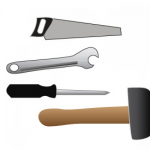What Tools Do Technical Writers Use
 Students and others trying to break into technical writing are always wondering what tools they should use. The latest tools survey from WritersUA seems helpful in answering this question.
Students and others trying to break into technical writing are always wondering what tools they should use. The latest tools survey from WritersUA seems helpful in answering this question.
The survey concludes that some of the most popular tools for technical writers are Adobe Acrobat, Camtasia Studio, Adobe Captivate, Dreamweaver, Madcap Flare, Framemaker, Photoshop, Robohelp, Snagit, and Visio.
Of these tools, Flare scores highest as a tool that participants can't live without. They ranked it as a 5, meaning "very important." Presumably this is because Flare does an excellent job in single sourcing to other formats, such as print and mobile. It's an all-in-one solution, so it by definition it's important or you're not using the tool correctly.
The WritersUA survey is a little frustrating because these tools aren't grouped by category. Some are screen capture tools, others are PDF conversion tools, others are image editing tools, others are video recording tools. I use Photoshop and Snagit, but ranking these along with Robohelp and Flare is to compare apples to oranges. Similarly, Camtasia Studio and Captivate are in another category. It would be helpful to sort the tools by category. (Still, it's nice to see someone doing a tools survey in the first place.)
Of the help authoring tools, it's interesting to see Flare rank so high. Flare is an excellent help authoring tool, and with a knowledge of CSS you can completely customize the webhelp and print output to look professional. However, its main failure is the lack of collaborative authoring. If you have 15 writers all contributing to the same help project, you have to import the content from other authors. They can use supporting tools such as Madcap Contribute, or Word templates. You can also try hosting Flare on SharePoint and enabling collaboration this way.
But I'm guessing that Flare is popular because most technical writers are solo sailors on their own ship, without the need for collaboration from other writers. In my career, the number of collaborative projects has been very small. I am usually the only writer for the project, which means collaborative authoring is unimportant. I don't need a central repository installed on a server that numerous authors can access and pull content from. Content is also not reused between projects, since each documentation project covers a different product.
Sarah O'Keefe also has some comments on the WritersUA tools survey. See her post, The passion quotient. She notes that the survey highlights "the tool for which the importance is ranked the highest." Despite this criteria in evaluation, I am not sure how I would design the tools survey differently.
About Tom Johnson

I'm an API technical writer based in the Seattle area. On this blog, I write about topics related to technical writing and communication — such as software documentation, API documentation, AI, information architecture, content strategy, writing processes, plain language, tech comm careers, and more. Check out my API documentation course if you're looking for more info about documenting APIs. Or see my posts on AI and AI course section for more on the latest in AI and tech comm.
If you're a technical writer and want to keep on top of the latest trends in the tech comm, be sure to subscribe to email updates below. You can also learn more about me or contact me. Finally, note that the opinions I express on my blog are my own points of view, not that of my employer.

